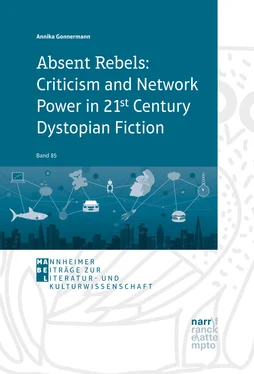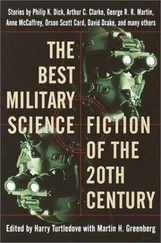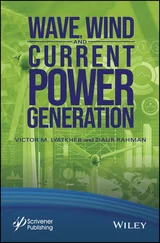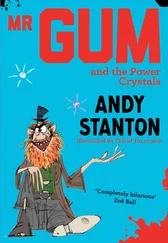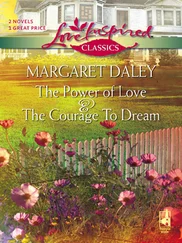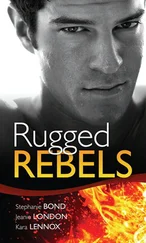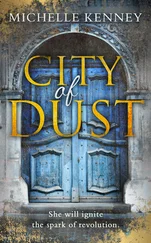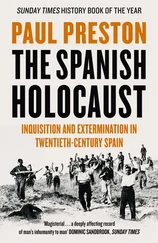Annika Gonnermann - Absent Rebels - Criticism and Network Power in 21st Century Dystopian Fiction
Здесь есть возможность читать онлайн «Annika Gonnermann - Absent Rebels - Criticism and Network Power in 21st Century Dystopian Fiction» — ознакомительный отрывок электронной книги совершенно бесплатно, а после прочтения отрывка купить полную версию. В некоторых случаях можно слушать аудио, скачать через торрент в формате fb2 и присутствует краткое содержание. Жанр: unrecognised, на английском языке. Описание произведения, (предисловие) а так же отзывы посетителей доступны на портале библиотеки ЛибКат.
- Название:Absent Rebels: Criticism and Network Power in 21st Century Dystopian Fiction
- Автор:
- Жанр:
- Год:неизвестен
- ISBN:нет данных
- Рейтинг книги:3 / 5. Голосов: 1
-
Избранное:Добавить в избранное
- Отзывы:
-
Ваша оценка:
- 60
- 1
- 2
- 3
- 4
- 5
Absent Rebels: Criticism and Network Power in 21st Century Dystopian Fiction: краткое содержание, описание и аннотация
Предлагаем к чтению аннотацию, описание, краткое содержание или предисловие (зависит от того, что написал сам автор книги «Absent Rebels: Criticism and Network Power in 21st Century Dystopian Fiction»). Если вы не нашли необходимую информацию о книге — напишите в комментариях, мы постараемся отыскать её.
Absent Rebels: Criticism and Network Power in 21st Century Dystopian Fiction — читать онлайн ознакомительный отрывок
Ниже представлен текст книги, разбитый по страницам. Система сохранения места последней прочитанной страницы, позволяет с удобством читать онлайн бесплатно книгу «Absent Rebels: Criticism and Network Power in 21st Century Dystopian Fiction», без необходимости каждый раз заново искать на чём Вы остановились. Поставьте закладку, и сможете в любой момент перейти на страницу, на которой закончили чтение.
Интервал:
Закладка:
Yet this uncritical belief in the positive results of the application of scientific logic starts to crumble when the “maelstrom of the nineteenth century would dramatically transform speculative fiction” (Hammond, Cold War 4). The end of the 19 thcentury witnesses the ideological and literary deconstruction of eutopia as a concept (cf. Murphy, “Eutopia” 479).6 What is usually referred to as ‘dystopian turn’ denominates the slow process of ‘replacing’ eutopian with dystopian writing, that is a switch in popularity. While influential eutopias were, of course, still being written during that time – Edward Bellamy’s futuristic time travel tale Looking Backward: 2000–1887 (1888) must be mentioned here – it is the 19 thcentury that witnesses the rise of what Tom Moylan calls “literary utopia’s shadow”: dystopia “emerged as a literary form in its own right in the early 1900s“ ( Scraps xi). In Erewhon (1872) for instance, – an anagram of “nowhere” and intertextual reference to More’s Utopia – Samuel Butler warns that “not all [e]utopias can be trusted” (Houston). His novel criticises the use of technology and banishes machines “altogether because of their tendency to tyrannize the men who made them” (Booker, Impulse 6). Oscillating between an eutopian and dystopian mode, the anonymously published novel criticises Victorian society, the Church, and Darwinian theories of evolution (cf. Hug 55). Yet, the rise of dystopia is connected to two other names: H.G. Wells and his belief in social improvement and the satires thereof by E.M. Forster (cf. Seeber, “Handeln” 190). In fact, Forster’s short story “The Machine Stops” (1909) depicts the fate of a degenerate human race living underground in isolation, entirely dependent on an omnipotent, God-like machine that runs the entire planet (cf. N. Wilkinson and Voigts 90):
By [Vasthi’s] side, on the little reading-desk, was a survival from the ages of litter – one book. This was the Book of the Machine. In it were instructions against every possible contingency. […] Sitting up in the bed, she took it reverently in her hands […] Then, half ashamed, half joyful, she murmured ‘O Machine! O Machine!’ and raise the volume to her lips. (“Machine” 8f.)
Criticising the “homogenisation of culture and elimination of personal freedom in totalitarian systems” (N. Wilkinson and Voigts 91), Forster’s text predicts a degenerative state humans find themselves in once they have transferred their agency to machines, thereby introducing topics that are to define the dystopian genre in the coming decades. In fact, Forster’s legacy has been stressed by various scholars. Acknowledging his pioneer work, Tom Moylan asserts that “Forster wrote against the grain of an emergent modernity” ( Scraps 111; cf. also Zeißler 33) and based on Forster’s critical evaluation of humanity’s use of technology and detachedness of humans from nature, Graham J. Murphy claims that Forster’s short story “has the strongest claim to being dystopia’s originary text” (“Dystopia” 473). In short, with the dawn of the 20 thcentury, it is the genre of eutopia that continues to lose “popularity and political efficacy” (Murphy, “Eutopia” 481) to its darker twin.
While Forster remains a pioneer of the genre, dystopia’s success story is associated with the names of three other writers: George Orwell, Aldous Huxley, and Yevgeny Zamyatin, whose respective texts have been identified as the ‘high priests’ of dystopian fiction.7 To this day, these titles are “still inseparably connected to the term dystopia” (Boller 3). Moreover, Tom Moylan argues that
as the socialist state or the consumer society claimed to have achieved [e]utopia, the more radical critique that the genre is capable of escaped into the mountains of negativity and re-emerged as the dystopia, the narrative that images a society worse than the existing one. In the great narrative works of Zamyatin ( We ), Huxley ( Brave New World ), Orwell ( 1984 ) [sic!] , and others, [e]utopian figures of hope were transmuted into an attack on present social systems which claim to be already existing [e]utopias. ( Impossible 8f.)
Once dystopia had been established as a literary form, it “took its place in the narrative catalogue of the West and developed in several forms throughout the rest of the century” (Baccolini and Moylan, “Introduction” 1). Authors and directors from all over the globe such as Kurt Vonnegut, Ray Bradbury, Ursula K. Le Guin, Joanna Russ, William Gibson, Ridley Scott, Margaret Atwood, Marge Piercy, Don De Lillo, Anthony Burgess, Philip K. Dick, Octavia E. Butler – to mention only the most prominent names –, continued to develop and enhance the dystopian genre, whose boundaries and conventions had been established back in the 1940s and 1950s (cf. Schmeink, “Cyberpunk” 223), moulding new sub-genres of dystopia, such as Cyberpunk8 or the ‘critical utopia’9 and thus developing the genre further.
From the 1960s to the present, dystopias have enjoyed an unbroken and “remarkable popularity” (Voigts, “Introduction” 1):10 Murphy states that “there can be little doubt that the dystopia thrived in the twentieth century and continues to show its health in the new millennium” (“Dystopia” 477),11 while Fredric Jameson asserts that “ours is a time when Anti-Utopia reigns supreme“ (quoted in Moylan, Scraps 139).12 Old classics and newly written Young Adult novels (YA) conquer the world’s best seller lists.13 As Kunkel writes, “[e]very other month seems to bring the publication of at least one new so-called literary novel on dystopian or apocalyptic themes and the release of at least one similarly themed movie” (“Dystopia” 90). While Rüdiger Heinze states that “dystopian visions in general have […] never gone out of fashion” (79), their boom is nevertheless remarkable. Christopher Ferns compares our obsession with dystopias to the interest of the Renaissance in eutopia: “dystopian fantasy has become in the modern era almost a myth in its own right […] and as such it continues to flourish” (15), while Jan Hollm states that the contemporary “description of post-apocalyptic horrors and the destruction of humankind are clearly linked to the catastrophe-inducing way of life in industrialised, globalised society at the beginning of the 21 stcentury” (381). What makes dystopia so fascinating is its ability to capture cultural anxieties and voice them in literary terms, so that it acts as a mouthpiece and tool of diagnosis and critique for social, political and economic developments.
3. Context, Criticism, and Rahel Jaeggi’s Critique of Forms of Life (2014)
To measure the life ‘as it is’ by a life ‘as it might or should be’ is a defining, constitutive feature of humanity. The urge to transcend is nearest to a universal, and arguably the least destructible, attribute of human existence. (Bauman, “Utopia with No Topos” 11)
Critique, in the words of Tom Boland, is an integral part of what defines human beings; he writes that critique is “part of our cultural history, a tradition which constitutes us as thinkers” ( Spectacle 1). Dystopia partakes in this long-standing tradition since it can be classified first and foremost as a literary expression of criticism.1 The novels dedicated to the socio-cultural analysis of the status quo serve as a “mouthpiece for social critique” (N. Wilkinson and Voigts 95), meaning that they criticise socio-political developments of their time of origin and are in turn shaped by political, economic, religious and ethical discourses of their respective contexts. Yet, while these novels are eager to paint the future in the bleakest colours possible, they are equally careful to establish causal-logical references linking back to their authors’ respective reality (cf. Sargent 27).2 As Terry Eagleton claims, they are “really devices for embarrassing the present” (“Utopias”).3 Each futuristic nightmare is thus in fact a moral enquiry into the state of affairs of the present , highlighting the weaknesses of the socio-cultural reality via extrapolation. This technique has been analysed by Darko Suvin, who frames it under the concept of ‘cognitive estrangement’ (cf. Metamorphoses 4ff.). This approach is best summarised as “a reflecting of but also on reality,” which forces readers to adopt an estranged perspective on the familiar. It constitutes a form of cognitive analysis that tends “toward a dynamic transformation rather than toward a static mirroring of the author’s environment” (ibid. 10). As Christopher Ferns claims,
Читать дальшеИнтервал:
Закладка:
Похожие книги на «Absent Rebels: Criticism and Network Power in 21st Century Dystopian Fiction»
Представляем Вашему вниманию похожие книги на «Absent Rebels: Criticism and Network Power in 21st Century Dystopian Fiction» списком для выбора. Мы отобрали схожую по названию и смыслу литературу в надежде предоставить читателям больше вариантов отыскать новые, интересные, ещё непрочитанные произведения.
Обсуждение, отзывы о книге «Absent Rebels: Criticism and Network Power in 21st Century Dystopian Fiction» и просто собственные мнения читателей. Оставьте ваши комментарии, напишите, что Вы думаете о произведении, его смысле или главных героях. Укажите что конкретно понравилось, а что нет, и почему Вы так считаете.
